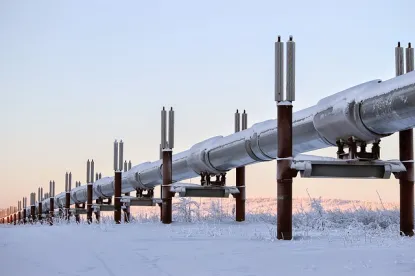PHMSA Proposes Requirements for Valves and Rupture Identification and Mitigation. PHMSA Issues Final Rule for Underground Natural Gas Storage Facilities. Updated PHMSA Rulemakings Chart.
PHMSA Proposes Requirements for Valves and Rupture Identification and Mitigation
On February 6, the Pipeline and Hazardous Materials Safety Administration (PHMSA) published a Notice of Proposed Rulemaking (NPRM) that would (1) require installation of remote-control valves (RCV), automatic shutoff valves (ASV), or equivalent technology on newly constructed and entirely replaced gas transmission pipelines, hazardous liquid pipelines, and carbon dioxide pipelines and (2) establish minimum standards for identifying ruptures, initiating pipeline shut-downs and improving emergency response effectiveness. The proposed rule responds to a directive in the Pipeline Safety, Regulatory Certainty, and Job Creation Act of 2011 and recommendations of the National Transportation Safety Board and the Government Accountability Office. Comments are due April 6.
New requirement to install ASV, RCV or equivalent technology. The NPRM proposes to require that newly constructed or entirely replaced segments of onshore gas transmission lines and hazardous liquid and carbon dioxide lines 6 or more inches in diameter be installed with ASVs, RCVs or equivalent technology. Manual valves may be installed only upon 90-day advance notification to PHMSA with a demonstration that installing ASVs, RCVs, or equivalent technology is economically, technically, or operationally infeasible. With respect to gas transmission pipelines, PHMSA proposes to implement this requirement by amending an existing design regulation (§ 192.179) specifying spacing requirements for sectionalizing block valves. For hazardous liquid pipelines, which are not subject to existing valve spacing requirements, PHMSA proposes a new valve spacing design regulation.
The NPRM explains that the term “entirely replaced” means that two or more contiguous miles of pipe are replaced with new pipe. The installation of ASVs, RCVs or equivalent technology would be required to satisfy new proposed rupture mitigation standards (proposed new §§ 192.634 and 195.418) and be able to isolate a pipeline segment within 40 minutes of a rupture. The NPRM also suggests that valves that are directly associated with or are otherwise affected by “entirely replaced” pipelines also would need to be upgraded to ASV, RCV or equivalent valve technology even if these valves are not on the replaced segment.
New rupture identification and mitigation standards. The NPRM proposes new rupture identification and mitigation requirements that apply to (1) onshore gas transmission pipelines 6 or more inches in diameter constructed or entirely replaced in high consequence areas (HCA) or Class 3 or Class 4 locations and (2) onshore segments of hazardous liquid pipelines 6 or more inches in diameter constructed or entirely replaced if they could affect an HCA.
Operators of affected pipelines would be required to install rupture mitigation valves that would completely isolate a designated “shut-off” segment from all product flow, including from lateral pipelines flowing into the designated shut-off segment, within 40 minutes of identifying a rupture. Rupture mitigation valves also would be required to be capable of actuating in one of several specified methods to mitigate a rupture within 40 minutes and have certain specified monitoring and operational capabilities.
Gas transmission pipe replaced after a class location change must comply with new requirements even if pipe does not extend for 2 contiguous miles. If an operator of a gas transmission pipeline replaces pipe in order to satisfy maximum allowable operating pressure requirements following a change in class location, the operator must install ASVs, RCVs, or equivalent technology and comply with valve spacing requirements and the new rupture identification and mitigation standards. This requirement appears to apply regardless of whether the replaced pipe extends for 2 contiguous miles.
“Rupture” would be a newly defined term. The NPRM proposes to define the term ‘‘rupture’’ to mean an uncontrolled release of a large volume of product. For gas pipelines, a rupture includes an unanticipated or unplanned pressure loss of 10 percent or more occurring within 15 minutes and an unexplained flow rate change, pressure change, instrumentation indication, or equipment function. For hazardous liquid pipelines, a rupture includes an unanticipated or unplanned flow rate change of 10 percent or more or a pressure loss of 10 percent or more occurring within 15 minutes. In either case, a rupture excludes circumstances where the operator has documented in advance the need for pressure or flow rate changes.
Operators would be required to modify their emergency plans. Operators would be required to add provisions to their emergency plans for (1) establishing and maintaining adequate means of communicating with appropriate public safety answering points (i.e., 9-1-1 call centers), other emergency responders, and public officials regarding their jurisdiction, resources and contact information; (2) taking actions to minimize hazards associated with releasing product and evaluating and identifying actual rupture events within 10 minutes of initial notification; and (3) notifying the appropriate public safety answering point, first responders and public officials of pipeline emergencies to coordinate and share information regarding the release and planned and actual responses.
Operators would be required to investigate failures and accidents. Operators must establish and follow procedures for investigating and analyzing failures after an incident or accident; incorporate lessons learned from post-incident or accident reviews into procedures; analyze the factors affecting release volume and consequences and implement preventive and mitigative measures to reduce or limit the release volume and damage in a future failure; and summarize a post-incident/accident review within 90 days of the failure or incident while the investigation is pending.
Operators would be required to implement revised valve maintenance requirements. The proposed rule would require that, for ASVs, RSVs or other valves based alternative equivalent technology, an operator must conduct point-to-point verification between SCADA displays and mainline valve, sensors, and communications equipment and verify that manual and locally operated rupture mitigation valves can respond within 40 minutes of detecting a rupture. The biannual inspection would need to include partial operation of the valve for both natural gas and hazardous liquid pipelines.
Operators of gas transmission pipelines would be required to implement new preventive and mitigative measures. The NPRM proposes to amend integrity management regulations to require installation of ASVs, RCVs or equivalent technology on gas transmission pipelines if an operator determines they would be an efficient method of protecting an HCA in the event of a release. The NPRM specifies considerations for making such a determination.
The NPRM does not propose leak detection measures. The NPRM does not propose requiring leak detection equipment on gas transmission and distribution pipelines because of the difficulty in detecting smaller leaks in an operationally, technically, and economically feasible manner. PHMSA will continue to address the effectiveness of leak detection systems in a future rulemaking, as part of research and development efforts, and through engagement in the development of new or updated standards. PHMSA also noted that the NPRM’s proposal to require installation of pressure monitoring equipment on all rupture mitigation valves will facilitate better detection of ruptures and possibly leaks.
PHMSA Amends Safety Standards for Underground Natural Gas Storage Facilities
On February 12 PHMSA issued a final rule adopting safety standards applicable to underground natural gas storage facilities. The new regulations become effective on March 13, 2020, with several specific compliance deadlines described below.
The Protecting Our Infrastructure of Pipelines and Enhancing Safety Act of 2016 (PIPES Act) required PHMSA to issue safety standards for underground natural gas storage facilities. To the extent practicable, PHMSA was directed to consider consensus standards, environmental protection, integrity management, and economic impacts. In December 2016, PHMSA issued an Interim Final Rule (IFR) incorporating by reference into PHMSA’s Part 192 safety standards two recommended practices (RP) of the American Petroleum Institute (API), the July 2015 edition of API RP 1170, “Design and Operation of Solution-Mined Salt Caverns Used for Natural Gas Storage,” and the September 2015 edition of API RP 1171, “Functional Integrity of Natural Gas Storage in Depleted Hydrocarbon Reservoirs and Aquifer Reservoirs. Among other things, the IFR required that operators of underground natural gas storage facilities comply with API RP 1170 and 1171, including their non-mandatory provisions, by January 18, 2018. PHMSA later stayed enforcement of the non-mandatory provisions.
The final rule modifies the IFR in several ways. Key provisions of the final rule are described below:
Operators are not required to comply with non-mandatory provisions of API RP 1170 and RP1171. The final rule retains API RP 1170 and API RP 1171 as the basis for regulating safety of underground natural gas storage and continues to incorporate them by reference into the regulations. In a departure from the IFR, however, operators are not required to treat non-mandatory provisions as mandatory directives. In the final rule, PHMSA states that “because these non-mandatory provisions are closely tied to the mandatory provisions that operators must meet, any non-mandatory provision remains enforceable to the extent that it is necessary, in the context of a particular operator or facility, to ensure compliance with a mandatory provision.” An operator also will not be required to justify why it does not implement a non-mandatory provision.
In response to comments stating that codifying storage regulations in Part 192 could cause confusion regarding the applicability of other Part 192 regulations to storage, PHMSA also modified the definition of an underground natural gas storage to exclude components of a gas pipeline facility that are subject to other provisions of Part 192. The final rule also added introductory language to § 192.12 clarifying its application.
Operators must apply integrity management principles to storage facilities. The final rule requires that operators apply integrity and risk management principles to underground natural gas storage facilities. Key provisions include:
-
Operators of salt cavern storage facilities must apply the risk management principles of section 8 of API RP 1171 which applies to depleted reservoirs and aquifers. Section 8 of 1171, which has no counterpart in API RP 1170, outlines a framework for data collection, threat and hazard analyses, risk assessment methodology, preventive and mitigative measures, risk monitoring, and record-keeping. Operators of salt-cavern underground natural gas storage facilities will be required to apply these provisions to the extent they apply to the physical characteristics and operations of solution-mined salt caverns.
-
All operators of underground natural gas storage facilities must have integrity management plans that include the elements specified in new 49 C.F.R. § 192.12(d).
-
Operators must complete all baseline assessments for reservoirs and salt caverns and 40% of individual wells, starting with highest risk wells first, by March 13, 2024. Baseline assessments for the remaining 60% of wells must be completed by March 13, 2027.
-
Operators must perform periodic assessments and comply with recordkeeping requirements.
The compliance deadlines for implementing the requirements of API RP 1170, API RP 1171, and integrity management programs are set forth below.
Compliance Deadlines for Solution-Mined Salt Caverns |
|||
|
Requirement |
Constructed before 7/18/17 |
Constructed between 7/18/17 and 3/13/20 |
Constructed after 3/13/20 |
|
Implement API RP 1170 |
1/18/2018 (§§9, 10, 11 only) |
Before commencing operations |
Before commencing operations |
|
Implement §8 of API RP 1171 |
3/13/21 |
3/13/21 |
|
|
Prepare and follow written procedures (§192.12(c)) |
1/18/2018 |
Before commencing operations |
|
|
Implement integrity management (§192.12(d)) |
3/13/21 |
3/13/21 |
|
|
Perform baseline assessments of reservoirs and caverns and 40% of individual wells |
3/13/2024 |
3/13/2024 |
3/13/2024 |
|
Perform baseline assessments of remaining 60% of wells |
3/13/2027 |
3/13/2027 |
3/13/2027 |
Compliance Deadlines for Depleted Reservoirs and Aquifers |
||
|
Requirement |
Constructed on or before before 7/18/17 |
Constructed after 7/18/17 |
|
Implement API RP 1171 |
1/18/2018 (§§8, 9, 10, 11 only) |
Before commencing operations |
|
Prepare and follow written procedures (§192.12(c)) |
1/18/2018 |
|
|
Implement integrity management (§192.12(d)) |
3/13/21 |
|
|
Perform baseline assessments of reservoirs and caverns and 40% of individual wells |
3/13/2024 |
3/13/2024 |
|
Perform baseline assessments of remaining 60% of wells |
3/13/2027 |
3/13/2027 |
The final rule narrows the scope of the reporting requirements. The final rule narrows the notification requirement to make clear that operators are not required to notify PHMSA of routine maintenance activities. Notification of facility changes is limited to plugging or abandonment activities (regardless of cost) and construction or maintenance requiring a workover rig costing $200,000 or more. The final rule also added an emergency exemption to the 60-day notification requirements.
The final rule declines to modify the application to state-regulated storage facilities. The final rule retains the requirement that states update their safety regulations to include the provisions of the API RP 1170 and API RP 1171 ensure that the state authority responsible for overseeing the safety of underground natural gas storage facilities (if not the agency responsible for the safety of pipelines) has submitted a certification to PHMSA pursuant to § 60105 of the Pipeline Safety Act. PHMSA explained that states can implement additional and more stringent safety requirements as long as they are consistent with federal requirements. The final rule also emphasized that the final rule does not interfere with state siting or permitting authorities or regulation of natural gas production.
Updated PHMSA Rulemakings Chart. The chart below shows the status of PHMSA’s pending pipeline safety rulemakings as reflected in (1) the Department of Transportation’s (DOT) February Significant Rulemaking Report, (2) PHMSA’s status Chart of legislatively mandated actions, and (3) the Office of Management & Budget’s (OMB) Office of Information and Regulatory Affairs (OIRA) Fall 2019 Unified Agenda of Regulatory and Deregulatory Actions. The Unified Agenda appears in two principal parts, Current Agenda Agency Regulatory Entries for Active Actions and Current Long Term Actions. New information is in bold.
Updated PHMSA Rulemakings Chart. The chart below shows the status of PHMSA’s pending pipeline safety rulemakings as reflected in (1) the Department of Transportation’s (DOT) February Significant Rulemaking Report, (2) PHMSA’s status Chart of legislatively mandated actions, and (3) the Office of Management & Budget’s (OMB) Office of Information and Regulatory Affairs (OIRA) Fall 2019 Unified Agenda of Regulatory and Deregulatory Actions. The Unified Agenda appears in two principal parts, Current Agenda Agency Regulatory Entries for Active Actions and Current Long Term Actions. New information is in bold.
Pending Final Rules
|
Proceeding |
DOT Estimated Publication |
OIRA Estimated Publication |
PHMSA’s Chart |
|
Safety of Gas Transmission Pipelines, Repair Criteria, Integrity Management Improvements, Cathodic Protection, Management of Change, and Other Related Amendments |
July 24, 2020 |
March 2020 |
Not Listed |
|
Safety of Gas Gathering Pipelines |
July 24, 2020 |
June 2020 |
Not Listed |
|
Underground Natural Gas Storage Facilities |
Published February 12, 2020 |
||
Pending Notices of Proposed Rulemakings
|
Proceeding |
DOT Estimated Publication |
OIRA Estimated Publication |
PHMSA’s Chart |
|
Amendments to LNG Facilities |
September 17, 2020 |
January 2020 |
January 20,2020 |
|
Class Location Requirements |
July 22, 2020 |
April 2020 |
Not Listed |
|
Gas Pipeline Regulatory Reform |
January 29, 2020 |
January 2020 |
Not Listed |
|
Liquid Pipeline Regulatory Reform |
Not Listed |
November 2019 |
Not Listed |
|
Periodic Standards Update |
Not Listed |
December 2019 |
Not Listed |
|
Repair Criteria for Hazardous Liquid Pipelines |
June 26, 2020 |
June 2020 |
Not Listed |
|
Valve Installation and Minimum Rupture Detection Standards |
Published February 6, 2020 |
||
Pending Advance Notices of Proposed Rulemakings
|
Proceeding |
DOT Estimated Publication |
OIRA Estimated Publication |
PHMSA’s Chart |
|
Coastal Ecological Unusually Sensitive Areas |
February 20, 2020 |
December 2019 |
April 13, 2020 |







 />i
/>i

